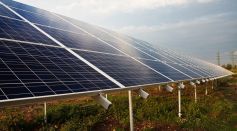Tags: Renewable energy

Elsevier And ISES Announce Coldbox Store As This Year’s Renewable Transformation Challenge Prize Winner

VinFuture Foundation Hosts Public Dialogue About 'Renewable Energy & New Materials For The Future' With Nobel-Winning Professor
Underwater Cables Attract Crabs: How Do Biological Changes Result from Electromagnetic Field Emitted by Renewable Energy?

Novel Way of Generating Renewable Biofuel Additives Could Use Radiation Derived From Nuclear Waste
New Renewable Energy Source Discovered in Bacteria; Tiny Biofuel Provider Probably Existed Before Life on Earth

Calcium Imide: Catalyst To Extract Hydrogen Fuel From Ammonia; Step Towards Efficient Green Energy Harvest

Renewable Energy: How Green Hydrogen Will Bridge The Gap for Energy Transition

Traditional Dams Can Produce Sustainable Energy; Massive Flood Barriers Upgrade Will Produce Future Hydropower

Hydro-Quebec Launches Its First Solar Power Plants; Panel Station Named After Its First Female Engineer

Lint-Microfibers Found in Clothes Dryers Can be Converted Into Energy Using Pyrolysis Treatment

Friction-Powered Clothing Can Give Self-Sufficient Energy for Wearables

Solar Power: What's Keeping Airports from Turning Into Giant Solar Farms?

Should We Blame Wind Turbines for Texas' Power Outages?
Commercial Carbon Capture and Use, Taking One Step Ahead with Leading Companies in the Industry

Computer Scientists, Energy Tech Experts Collaborate in Making Solar Energy More Efficient
Nanomaterials Improve Hybrid Flow Battery Electrodes, Advancing Renewable Energy Storage

Peruvian Biologist Wins Annual UN Environmental Award
World's Largest Renewable Energy Megapark in India Is As Big As Singapore
Renewable Energy and Its Role To a Clean Energy Future
Plant Power May Tackle Several Sustainable Development Goals
Most Popular

Can the World Run Out of Water? Water Scarcity Science and Climate Impact Explained

Volcanic Warning Signs: How Magma Movement Reveals Eruption Prediction Clues for Geologists

Solar Maximum 2026: Inside the Sunspot Cycle and Solar Activity Forecast Astronomers Are Watching

How Tsunamis Form and Travel at Extreme Speeds: Seismic Waves and Coastal Hazards





